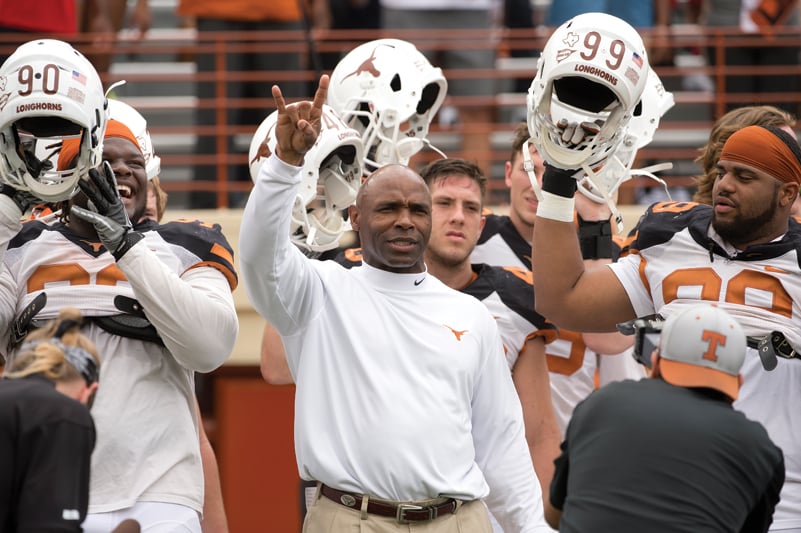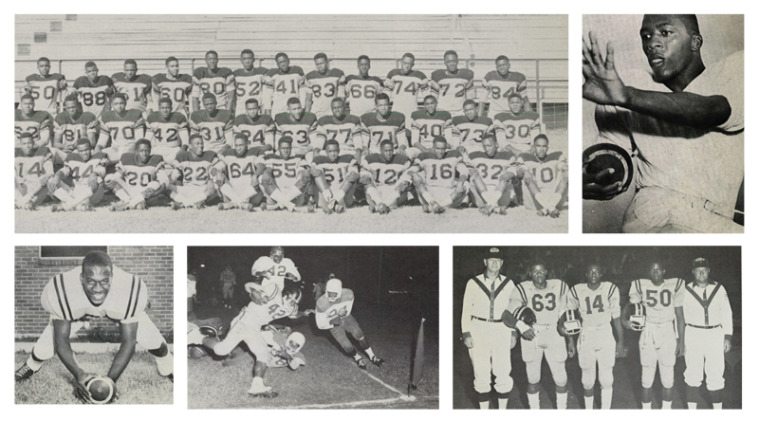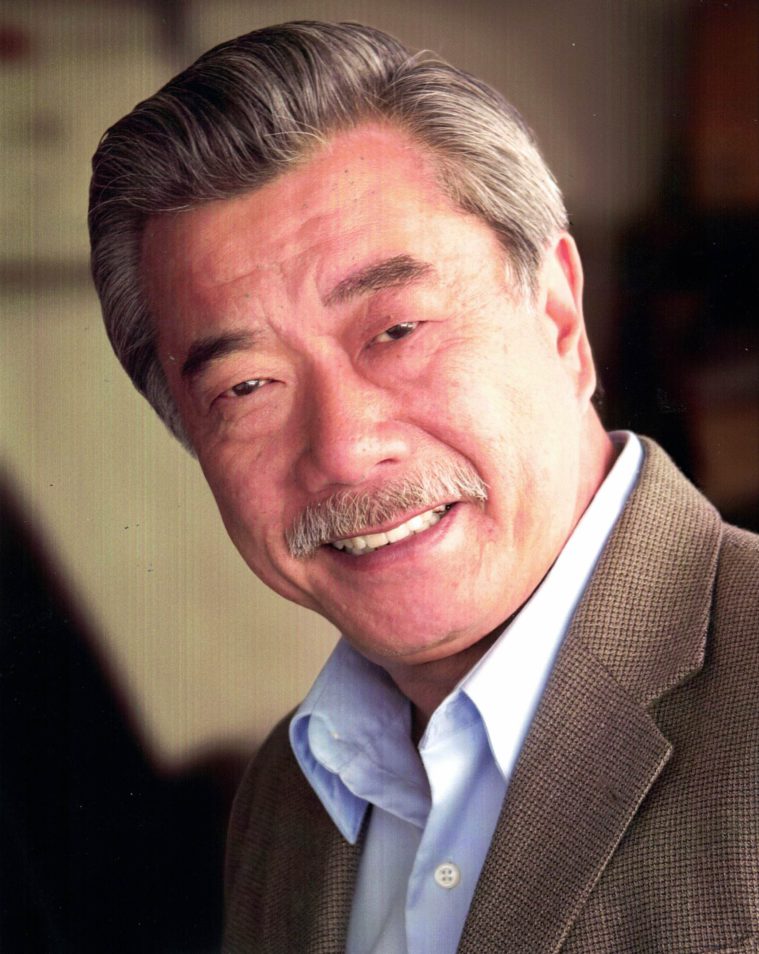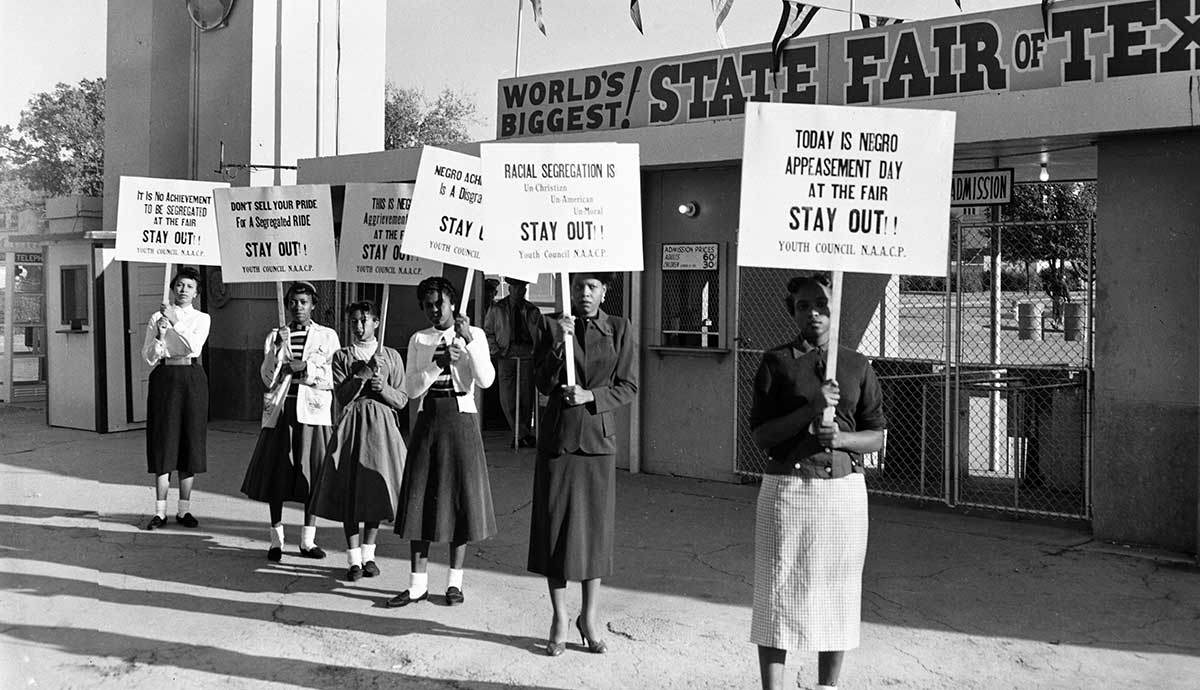
Forward Motion
Charlie Strong and Texas football's long journey out of segregation.

A version of this story ran in the September 2014 issue.
Above: Charlie Strong and players after the annual Orange-White scrimmage.
Among the memorabilia displayed in the offices of the Prairie View Interscholastic League Coaches Association is a photograph of L.C. Anderson High School’s 1942 state championship football team. The black-and-white photo has been enhanced so the uniforms appear bright yellow, as befits the school’s Yellow Jacket mascot.
The Dec. 12, 1942, issue of the Austin American contained a short three-paragraph description of Anderson’s title game, while reserving the top of that day’s sports page for the big news: “Austin Blasts Way Into State Semi-Finals.”
“Austin,” in this case, referred to L.C. Anderson’s cross-town analog, Austin High School, and 14 days later, after a season reported by the Austin American in painstaking detail, Austin High won the University Interscholastic League state football championship.
The university’s most prized institution is now in the hands of a black head coach. And everyone is watching.
During the five decades that both the University Interscholastic League and the Prairie View Interscholastic League existed, 1942 was the only year in which Austin claimed both leagues’ state championship teams. Austin High and L.C. Anderson were Austin’s only high schools in 1942. Anderson was the high school for students of color, and Austin High was for white students only.
Like so many Southern institutions, Texas’ high school interscholastic leagues were segregated. Ed Roby, who played football at Anderson before graduating in 1960, is now executive director of the Prairie View Interscholastic League Coaches Association, which preserves the history of the league, which was dissolved in the late 1960s and absorbed into the University Interscholastic League in the early 1970s. The Prairie View League, Roby explains, was created in the 1920s, “because the UIL wouldn’t let us come in then. They were a bunch of racists and they wouldn’t let us in.”
Ed Roby believes that Austin High and L.C. Anderson had “the best two teams in the state” in the late 1950s. “They never got to play,” he says, “and they were right across town.” In addition to its 1942 title, Anderson’s football team won the Prairie View Interscholastic League championship in 1956, 1957 and 1961. Austin High, meanwhile, went to the University Interscholastic League playoffs in 1957 for the final time that century, led by quarterback Mike Cotten, who went on to quarterback the University of Texas Longhorns. Despite the demonstrated talent on Anderson’s football teams, no Anderson players ever got a chance to suit up for the Longhorns, which remained a segregated team until 1970.

Austin is a football town, from the 100,000-seat Darrell K Royal-Texas Memorial Stadium to the Vince Young Steakhouse. Drew Brees, quarterback for the New Orleans Saints, and Michael Griffin, a safety for the Tennessee Titans, both played high school football in Austin. The Lake Travis and Westlake high school teams consistently rank among the best in the state, with Lake Travis taking five consecutive state titles from 2008 to 2012.
Austin is also a town with a long history of segregation and racially disastrous efforts at urban renewal. A report released earlier this year by the Institute for Urban Policy Research & Analysis at the University of Texas showed that among the 10 fastest-growing major cities in the country, Austin is the only one to register a net loss in black population. The study’s authors suggest that “the declining number of African Americans in Austin was the result of persistent structural inequalities,” including skyrocketing property taxes due to gentrification, a “troubled relationship” between black residents and the Austin Police Department, disparities in public education, and lack of economic opportunity.
“They were a bunch of racists and they wouldn’t let us in.”
It was into this intersection of athletic greatness and racial quandary that Charlie Strong, the new coach of the University of Texas football team, stepped at the beginning of 2014.
Hired to replace Mack Brown, Strong became UT’s first-ever black head coach of a men’s team. University President Bill Powers released a statement on the occasion, writing, “This is a historic day for the University of Texas and a historic hire for our football team.” Powers didn’t explain what was historic about the hire. He didn’t need to.
Strong instantly became the embodiment of progress in a town that prides itself on progressiveness. He also became an easy target of racism both subtle and overt.
When Austin High won the University Interscholastic League championship on Saturday, Dec. 26, 1942, one of the multiple Austin American articles about the win described the joyous scene: “The cheers lifted in Memorial Stadium as a teen-age team skipped down the glory road to bring this first state championship to Austin.” The newspaper then declared, “The victory put Austin on the football map,” parenthetically noting titles “(… for the university and state championship for Anderson High, too, you know).”
A year earlier, in 1941, Texas football had enjoyed its first moment in the national spotlight. The University of Texas Longhorns were ranked No. 1 by the Associated Press for the first time, and Life magazine featured 14 UT players on its Nov. 17 cover. In 1943, a year after Austin High and Anderson High won their respective leagues’ football championships, UT won the Southwest Conference championship and the team’s first Cotton Bowl game.
Austin was the center of Texas football, and football was well on its way to becoming the unofficial religion of Texas.
These three schools put Austin football on the map, yet profound physical and cultural barriers divided Anderson from Austin High and UT. While the two high schools were less than 2 miles apart, with UT between them, the separation was immense. East Avenue, which once ran where Interstate 35 now bisects the city, served as the dividing line between the western part of town, where white Austinites lived, and the eastern part, where people of color were consigned. In 1928, the Austin City Council had approved a master plan for the city’s downtown. As Andrew Busch explained last year in the Journal of Urban History, the purpose of the plan was to “maintain the nonindustrial, nonurban qualities that characterized Austin” by forcing people of color to move east of downtown. The city “simply relocate[d] segregated facilities, which were legal at the time, to one district, and cut off facilities to minorities in all other parts of the city.” By 1932, almost all of Austin’s black residents lived east of East Avenue. Black people were barred from most public playgrounds, restrooms and movie theaters west of that road. House Park, where Austin High played most of its football games, was a whites-only space.
Black people were also not found on the field or in the stands of UT’s Memorial Stadium. Only white players donned Longhorn uniforms. Raye Virginia Allen, whose late husband, H.K. Allen, played on the 1942 Austin High team, told me that H.K., like many of his high school teammates, “went from playing ball at Austin High to getting a scholarship on the Longhorn team. There was a lot of crossover” between the local high school and the university.
Ed Roby believes it took so long for UT to hire a black man as head coach of a men’s team because, “With UT’s reputation, I don’t think anyone applied really.”
The same opportunities were not available to Anderson graduates. One of the best football players ever to emerge from the city of Austin was Dick “Night Train” Lane, who played on the 1945 Anderson High team that went to the state finals, losing to Wichita Falls-Washington. In 1952, tired of working at an airplane factory, he asked the Los Angeles Rams for a tryout and ended up playing the next 13 years in the NFL. Lane still holds the record for interceptions in a single season: 14. Lane, who grew up just 2 miles from UT’s Memorial Stadium, retired from his NFL career in 1965, five years before the Longhorns fielded a black football player for the first time. He was inducted into the Pro Football Hall of Fame in 1974. When he died in 2002, The New York Times called him “a fearsome tackler who was perhaps the finest cornerback in pro football history.”
UT lacked black players not because black players didn’t want to play at UT, but because they were unwelcome.
In 1954, Marion Ford Jr. applied to the University of Texas and became one of the first five black undergraduates ever admitted. The historic Brown v. Board of Education Supreme Court decision had stripped away the legal underpinnings of separate-but-equal education only months earlier. Even so, the university rescinded the admissions of Ford and the other four black students after Ford gave an interview to a reporter with the Houston Post in which he indicated that he not only wanted an education at UT, but he also wanted to play football there. Just a year earlier, the UT regents had put in place a policy that barred “participation of Negroes in football games.” According to Dwonna Goldstone’s Integrating the 40 Acres, Ford’s interview resulted in “a brief meeting of the regents, university administrators, and Governor Allan Shivers” and the eventual cancellation of the admissions. In 1956, the first black undergraduates would finally matriculate at UT.
On Feb. 29, 1964, nearly a decade after Ford stated his desire to play Longhorn football, UT athletics finally began to integrate when Oliver Patterson and James Means ran in a track meet in College Station. But in the struggle to integrate sports at UT, football was always the primary concern. Goldstone states that many of the thousands of white Longhorn fans who crowded into Memorial Stadium on game days “saw the Texas football team as a bastion of white supremacy that could not be tainted by a black athlete.” She writes that administrators and coaches expressed concern about where an integrated team would stay during travel to away games, since hotels and restaurants across the South were segregated. UT officials, coaches and supporters, Goldstone writes, blamed the team’s lack of black players on the poor academics of black student-athletes.
When UT beat Arkansas in the 1969 college championship football game, both schools fielded all-white teams. In 1970, both Arkansas and UT integrated their teams, becoming the last two teams in the Southwest Conference to do so. (Southern Methodist University had been the first, in 1966.) By that time, Darrell K Royal, UT’s head football coach from 1957 to 1976, had already been recruiting black players for several years, but for various reasons none had made the team. Then Julius Whittier joined as a freshman in 1969, becoming the first black Longhorn football player. Due to contemporary NCAA rules barring freshmen from playing on varsity teams, Whittier was ineligible during the 1969 championship season. In 1970, with Whittier on the field, UT’s newly integrated team repeated as national champions.
It is no surprise that once UT opened its team to black players, some of the best athletes in the state began to play there. In 1974, future Heisman Trophy winner Earl Campbell, from Tyler, joined the team.
Black players had long wanted to don the burnt orange and take the field in Memorial Stadium. In the early 1960s, Ed Roby would watch UT practice. “I always wanted to play there,” he says, “but I couldn’t play there.”
No Anderson Yellow Jacket ever would. Due to a legal struggle between the federal government and the city of Austin, Anderson High was shuttered in 1971.
Inside the gleaming, high-ceilinged George Washington Carver Museum and Cultural Center on Angelina Street in East Austin, down a long hallway past a series of classrooms, you’ll find a new permanent exhibit about L.C. Anderson High. Alongside trophies and plaques recognizing the school’s accomplishments in marching band, theater and academics are displayed the football team’s Prairie View Interscholastic League championship trophies from 1942, 1956, 1957 and 1961. It took more than 30 years for the memorabilia to find a permanent home.
Austin is still a city divided.
A federal district court ordered the shutdown of L.C. Anderson in 1971 as part of an effort to speed desegregation in the Austin Independent School District. The closure was met with anger in East Austin. Harvey Merida, who graduated from Anderson in 1960 and now lives in Lockhart, explained residents’ attitudes to me this way: “Everything about segregation wasn’t all bad, and integration wasn’t all good. It was the bitter with the sweet.” The closure’s impact on East Austin’s black community was bitter. In a recent KLRU documentary about the history of civil rights in Austin, Linda Connor, a lifelong Austin resident who was attending Anderson when it was shut down, said, “The East 11th and 12th streets died. The neighborhood died, all because they closed the school.”
In 1974, a new Anderson High School opened in northwest Austin, retaining the name but changing the school colors and abandoning the Yellow Jacket mascot for a new Fighting Trojan. The old Anderson High’s trophies were packed away and, according to Danny Davis at the Austin American-Statesman, “were left without a home, gathered up for safe-guarding by Delores Duffie, an Anderson alum.”
Desegregation of Austin’s schools spanned the 1970s and finally ended in 1980, when the city and a U.S. district court came to a desegregation agreement resulting in an extensive busing program. Only three years later, in 1983, “the district court declared Austin’s schools desegregated and ended its court order,” as described by Andy Alford in the Austin American-Statesman. Alford then notes: “School trustees stopped busing most elementary students in 1986, triggering an inexorable slide back into segregation.”
The fights over integration paralleled struggles over land use and urban renewal during the 1960s and ’70s.
In 1965, the Legislature gave UT System regents power of eminent domain to expand the campus with little legal hassle. The regents used that power to acquire more than 70 acres in East Austin, according to geographer Eliot Tretter in his forthcoming book, Shadows of a Sun Belt City. Between that East Austin land grab and the appropriation of 30 acres near Brackenridge Hospital, from 1967 to 1975, Tretter writes, “UT [displaced] approximately 1,000 people, mostly African-Americans, and countless numbers of businesses, many African-American owned, were forced to close.” The city, meanwhile, oversaw five major urban renewal projects, each affecting East Austin. According to Andrew Busch in the Journal of Urban History, during the 1960s “large tracts of the central Eastside were razed.” Property was seized and homes were lost. Busch writes that the city’s urban renewal projects caused “a sharp rise in poverty and crime as residents of means [from the east side] moved further East and Northeast and poverty became concentrated” in communities of color. By 1977, “87 percent of central East Austin was deemed ‘low income’” and by 1990 “the rate of poverty had risen to a staggering 52 percent” in East Austin.
The results of this legacy remain obvious today. Maps drawn from 2010 census data show that most white Austinites still live west of I-35, and a small pocket of black residents reside east of 35 among a mainly Latino population. The UT report on Austin’s declining black population states that the city’s employment opportunities are centered on “technology, the service economy, and construction,” which largely leaves out black residents, who often do not have access to appropriate training for technology jobs. Employers in service and construction often choose to hire immigrant workers.
In terms of education, a 2012 study by the Texas Civil Rights Project confirmed that schools in wealthier, whiter areas of the city have access to far better resources than schools in poorer, blacker parts of the city. According to a ProPublica database, the Austin high schools with the highest percentage of black students are Lyndon B. Johnson (49 percent black) and John H. Reagan (25 percent black), which almost no white students attend. Both schools are located east of I-35, just 2.5 miles from each other.
Austin is still a city divided. In the middle of it all, just as it was in 1942, is the University of Texas campus and high-walled Darrell K Royal-Texas Memorial Stadium, where the Texas Longhorns play football.
“Black is the New Brown” T-shirts quickly appeared on Etsy, conflating Strong’s skin color with his predecessor’s surname.
Charlie Strong is not a man of many words. After his hiring in early January, plenty of sports pundits pointed to his verbal restraint as a reason he might not make a good fit for UT. The university’s football program is the most valuable in the nation, worth $139 million in 2013, which is “almost 20% more than any other team in the country,” according to Forbes.
Strong has been especially quiet about the historic nature of his hire. Ed Roby believes it took so long for UT to hire a black man as head coach of a men’s team because, “With UT’s reputation, I don’t think anyone applied really.” In Roby’s view, there were “a lot of black coaches that could have been hired,” but “Strong was one that was just fortunate enough to be hired.” Lifelong East Austin resident and UT fan Nat Bradford, who was one of the first black men to attend the university, describes the hire as pragmatic. “He was hired because of Kevin Sumlin at A&M, and because of [Sumlin’s] success.” Sumlin, hired in 2011 as Texas A&M’s first black head football coach, has coached two winning seasons of football, and Bradford believes that UT feared Sumlin could best a white UT head coach at recruiting black players.
Ben Carrington, a sociology professor at UT, was quoted at Sports On Earth about Strong’s hiring, saying that it “reminds [people] that the institution was a historically white institution. It reminds us of the facts of racial segregation and discrimination that took place at UT and its legacy into the present.”
That legacy can be a hard thing for people to come to terms with, especially in a city like Austin. When I asked a former Longhorn-turned-NFL pro for a statement about the groundbreaking nature of Strong’s hiring, and what it says about racial progress in Texas football, he politely declined, saying, “That’s actually a pretty sensitive subject for some that I’d rather steer clear from.” Businessman Red McCombs, one of UT’s biggest boosters and namesake of the university’s McCombs School of Business, went on San Antonio sports radio within days of Strong’s hiring to say, “I don’t believe [he belongs at] what should be one of the three most powerful university programs in the world right now at UT-Austin. I don’t think it adds up.” He drove his point home by describing the hire as “a kick in the face.” (McCombs later apologized for his comments.)
“Black is the New Brown” T-shirts quickly appeared on Etsy, conflating Strong’s skin color with his predecessor’s surname. The Dallas Morning News dug up an old quote from Strong’s former boss, legendary coach Lou Holtz, describing Strong as “not a hip-hop coach,” and a Fort Worth Star-Telegram reporter compared Strong to Arsenio Hall, Mack Brown to Jay Leno, and bemoaned giving up the latter for the former.
When I asked Strong for a statement about what his hiring might mean for the Austin community in particular, he responded, “I was talking to Floyd Keith, who used to be the executive director of the Black Coaches Association. He told me that what you need to think about is the African-American coaches that you’re representing right now that did not get the chances you’re getting. That’s all that needed to be said. I appreciate all of those that paved the way for me to have this opportunity, and what we need to do is continue to work to make it better.
“I want to change lives,” Strong said. “That is the only thing I’m looking to do.”
In 2005, weeks before UT, led by black quarterback Vince Young, beat the University of Southern California to win the national title, Julius Whittier, the first black player ever to play for the Longhorns, told The New York Times what it meant to him to watch such fully integrated teams compete.
“It completes the circle,” Whittier said, “from a team that had no blacks to a truly diverse one, one with a black athlete in the ultimate leadership position—quarterback—of the university’s most prized institution.”
In fact there is a position on any football team with higher priority and significance than quarterback, and that is head coach. The university’s most prized institution—which never recruited talent from the Anderson High Yellow Jackets, and which was the last in the nation to field an all-white championship team—is now in the hands of a black head coach. And everyone is watching.
The story of football in Austin parallels the story of race in Austin, and that story is still being written. The course of Charlie Strong’s tenure will tell us as much about Austin as about the city’s favorite sport.
To support journalism like this, donate to the Texas Observer.

